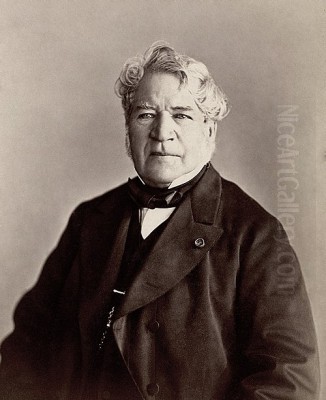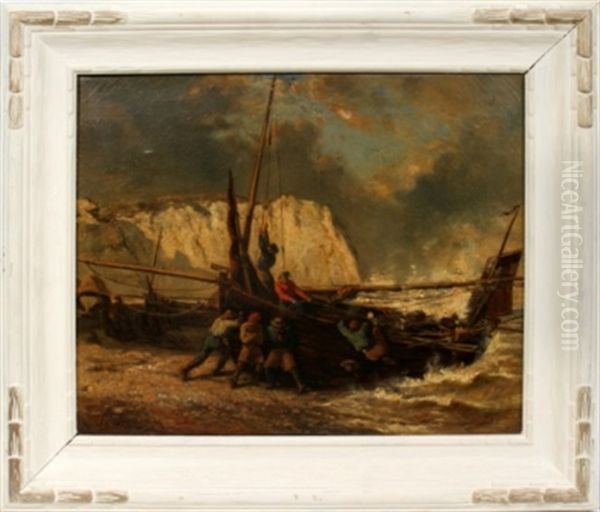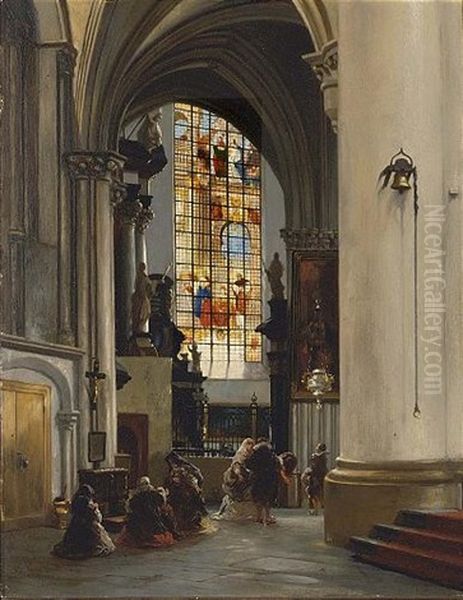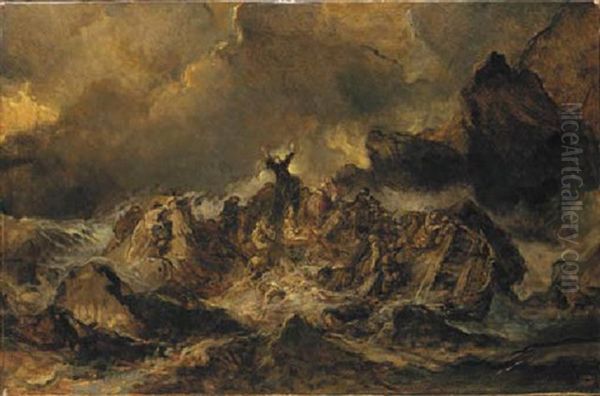Introduction: A Legacy Inherited

Louis-Gabriel-Eugène Isabey, born in Paris on July 22, 1803, entered a world already steeped in artistic prestige. He was the son of Jean-Baptiste Isabey, one of the most celebrated miniaturists and portrait painters of the Napoleonic and Restoration eras, a confidant of emperors and kings. This lineage provided young Eugène with both immense opportunity and significant pressure. The artistic salons and studios of Paris were familiar territory from his earliest years.
Despite this artistic environment, Eugène's initial ambitions lay elsewhere. The call of the sea, the allure of adventure and maritime life, initially captivated him more than the painter's easel. He harbored dreams of becoming a sailor, a path far removed from the refined world his father inhabited. However, Jean-Baptiste, recognizing his son's innate talent and perhaps wishing to secure the continuation of an artistic dynasty, firmly guided Eugène towards a career in painting.
This paternal insistence set the course for Eugène's life. While the sea would remain a profound source of inspiration, it would be captured on canvas and paper rather than experienced from the deck of a ship. His early life, therefore, was a blend of inherited artistic expectation and a personal fascination with the dynamic power of nature, particularly the ocean – themes that would dominate his prolific career. He passed away in Montévrain on April 25, 1886, leaving behind a significant body of work.
Artistic Formation: From Louvre Copies to Normandy Coasts
Eugène Isabey's formal artistic training began conventionally, yet was deeply enriched by his father's guidance and connections. He spent time honing his skills by copying the Old Masters at the Louvre Museum, a traditional rite of passage for aspiring artists in Paris. This practice allowed him to study composition, technique, and color firsthand from revered predecessors. Simultaneously, he absorbed the practical skills and sophisticated techniques directly from his father, Jean-Baptiste, whose own mastery of detail and finish undoubtedly left an imprint.

A pivotal step in his development was his move towards landscape painting and working directly from nature. He formed a collaborative relationship with the landscape painter Auguste-Xavier Leprince. Together, they embarked on sketching trips to Normandy. This experience was crucial, immersing Isabey in the practice of plein air (outdoor) painting, capturing the immediate effects of light and atmosphere on the coastal scenery. The rugged cliffs, bustling fishing ports, and changeable weather of the Normandy coast provided fertile ground for his burgeoning talent.
This period also saw him absorbing the influence of contemporary artists who were challenging classical norms. The burgeoning Romantic movement, with its emphasis on emotion, drama, and the sublime power of nature, resonated with Isabey's own inclinations. His early exposure to the works of British artists, particularly watercolorists, would also prove formative.
Debut and Rise to Prominence: The Salon of 1824
The year 1824 marked a significant turning point for Eugène Isabey and for French Romantic painting. He made his official debut at the prestigious Paris Salon, the most important art exhibition in France. At this very Salon, Eugène Delacroix, who would become the leading figure of French Romanticism, exhibited his controversial Massacres at Chios. The exhibition also featured landscapes by the English painter John Constable, whose fresh, naturalistic approach caused a sensation.
Amidst this exciting and somewhat revolutionary artistic climate, the young Isabey presented several marine paintings and landscapes. His work was well-received, signaling the arrival of a promising new talent. It was here that he likely encountered not only Delacroix but also the brilliant Anglo-French artist Richard Parkes Bonington. Bonington, though tragically short-lived (he died in 1828), was already renowned for his fluid watercolors and luminous oil paintings, particularly his coastal scenes.
Bonington's style, characterized by its freshness, technical brilliance, and atmospheric sensitivity, profoundly influenced Isabey. The two artists shared an affinity for similar subjects – harbors, beaches, and historical genre scenes – and Bonington's fluid brushwork and vibrant palette left a lasting mark on Isabey's developing technique, especially in watercolor. Isabey's success at the 1824 Salon, and subsequent Salons, quickly established his reputation, particularly as a painter of marine subjects.
The Lure of the Sea: Master of Marine Painting
Following his successful debut, Eugène Isabey rapidly became one of France's foremost marine painters. The sea, which had initially called to him as a potential career, became the dominant subject of his art for many years. He possessed an exceptional ability to capture the diverse moods of the ocean, from tranquil harbors bathed in sunlight to dramatic shipwrecks battered by storms. His canvases often depicted the vibrant life of coastal towns in Normandy and Brittany.

He rendered fishing boats returning with their catch, bustling quayside markets, and the dramatic architecture of port cities like Dieppe, Honfleur, and Saint-Malo. Works like Low Tide Harbor (1833), which was acquired by the state, exemplify his skill in depicting the complex interplay of boats, figures, water, and architecture, all unified by a keen sense of atmosphere. His brushwork was often energetic and textured, conveying the movement of waves and the bluster of wind.
Isabey's approach combined the dramatic flair of Romanticism with a detailed observation that bordered on Realism. He was influenced not only by Bonington but also by the tradition of Dutch Golden Age marine painting, artists like Willem van de Velde the Younger, known for their meticulous rendering of ships and seascapes. Yet, Isabey infused these scenes with a distinctly 19th-century sensibility, emphasizing the picturesque and often the dramatic aspects of maritime life. His Normandy Coast (1864) is a fine example of his mature style in this genre.
Ventures Abroad: The Algerian Experience
In 1830, a significant historical event offered Isabey a new artistic direction: the French military expedition to conquer Algiers. He was selected to be an official artist accompanying the naval forces, tasked with documenting the campaign. This voyage marked his first major trip outside France and exposed him to the landscapes, light, and culture of North Africa – a region that held exotic fascination for many European artists of the era, fueling the Orientalist movement.
During his time in Algeria, Isabey created numerous sketches, watercolors, and oil studies. He captured the bustling street life, the vibrant colors of local markets, and the distinctive architecture under the bright North African sun. Works such as The Cloth Dyer's Stall in Algiers (also known as In the Souk, Algiers), dating from this period, showcase his ability to render exotic scenes with lively detail and a sensitivity to light and shadow. These works contributed to the growing European visual vocabulary of the "Orient."

Interestingly, there's some historical nuance regarding this trip. While sources confirm his role as an official artist, some accounts suggest he may have had reservations or that his trip was relatively brief, possibly curtailed by concerns about stability. It's well-documented that Eugène Delacroix undertook a more extensive and famously influential journey to Morocco and Algeria slightly later, in 1832. Regardless of the exact duration or circumstances, Isabey's Algerian venture provided him with fresh subject matter and contributed to his versatility as an artist, even if, according to some reports, the initial public reception or market success of these specific works was modest, perhaps nudging him back towards more familiar European themes later.
Romanticism and Realism: A Synthesis of Styles
Eugène Isabey's artistic style is primarily associated with French Romanticism, yet it defies easy categorization, often blending Romantic drama with elements of Academic Realism and anticipating later trends. His connection to Romanticism is evident in his choice of subjects – shipwrecks, storms at sea, historical events – and his emphasis on atmosphere, emotion, and the power of nature. His energetic brushwork and often dramatic compositions align with the movement's core tenets, shared by contemporaries like Delacroix and Théodore Géricault.
His encounter with Richard Parkes Bonington was crucial in shaping his technique, particularly the fluid handling of paint and the capture of light, evident in both his oils and watercolors. He also absorbed lessons from British masters like J.M.W. Turner, whose atmospheric effects and dynamic portrayal of sea and sky resonated with Isabey's own interests, and John Constable, whose naturalism impressed many French artists at the 1824 Salon.
However, Isabey also maintained a strong sense of structure and detailed observation in his work, linking him to more traditional or academic approaches. His figures are clearly drawn, his architectural settings precise. This blend allowed his work to appeal to the official Salon juries and patrons while still conveying Romantic sensibility. He wasn't strictly aligned with the Barbizon School painters like Théodore Rousseau or Jean-François Millet, who focused on rural landscapes with a different mood, but he shared their commitment to observing nature directly, especially during his time painting along the Normandy coast with artists like Paul Huet.
Historical Scenes and Courtly Life
While marine painting remained a significant part of his output, Isabey increasingly turned his attention to historical subjects and genre scenes, particularly from the 16th and 17th centuries. This shift may have been partly motivated by the market, as historical paintings often commanded higher prices and greater prestige at the Salon. His works in this vein often depicted elaborate court ceremonies, duels, assassinations, or scenes of aristocratic life, rendered with rich costumes, detailed settings, and a flair for the dramatic.
His skill in depicting texture – silks, velvets, armor, aged stone – was particularly suited to these historical tableaux. Paintings like A Church Interior (1886), now in the Metropolitan Museum of Art, showcase his ability to handle complex interior scenes with dramatic lighting and meticulous detail, even late in his career. Some of his later historical works took on a darker, more violent tone, depicting massacres and battles with vivid intensity.
His growing reputation led to official recognition and patronage. During the July Monarchy, he became one of the court painters to King Louis-Philippe I, the "Bourgeois King." This position brought commissions and prestige. In 1832 (some sources say 1831), he was awarded the Cross of the Legion of Honour (Chevalier), a significant state accolade acknowledging his contribution to French art. This royal connection placed him alongside other artists favored by the regime, such as the prolific military painter Horace Vernet.
Master of Watercolor and Lithography
Beyond his achievements in oil painting, Eugène Isabey was a highly accomplished master of watercolor and lithography. His father, Jean-Baptiste, was renowned for his miniatures, often executed in watercolor, and Eugène inherited and adapted this facility for the medium, applying it often to landscapes and marine scenes. His watercolors are characterized by their fluidity, transparency, and atmospheric brilliance, rivaling those of his early influence, Bonington. He handled washes with dexterity, capturing the fleeting effects of light on water and sky.
His skill in watercolor led him to become a founding member of the Société des Aquarellistes Français (Society of French Watercolourists) in 1879. This organization aimed to promote watercolor as a serious art form, distinct from oil painting, and Isabey played a key role in its establishment and early exhibitions, lending his considerable prestige to the cause.
Isabey was also a prolific lithographer. Lithography, a relatively new printmaking technique in the early 19th century, allowed for greater tonal range and painterly effects than earlier methods. Isabey embraced its potential, creating numerous prints of landscapes, marine views, and genre scenes. He notably contributed illustrations to the monumental publication series Voyages Pittoresques et Romantiques dans l’Ancienne France (Picturesque and Romantic Travels in Old France), a vast project initiated by Baron Taylor that documented French historical sites and landscapes. His lithographs, like his paintings, often display dramatic compositions and a keen sense of place.
Isabey and His Contemporaries
Eugène Isabey navigated the vibrant and competitive Parisian art world for over six decades, interacting with many of the leading artists of his time. His early encounter with Delacroix and Bonington at the 1824 Salon placed him at the heart of the emerging Romantic movement. While his relationship with Delacroix seems to have been one of mutual respect within the same broad artistic current, their paths diverged somewhat, with Delacroix becoming the undisputed leader of Romantic figure painting and Orientalism, particularly after his influential 1832 North Africa trip.
Isabey maintained friendships and working relationships with landscape painters like Paul Huet, sharing excursions to paint outdoors. He was also associated with Camille Corot, another major figure bridging Romanticism and Realism, although Corot's landscapes generally possess a more serene and poetic quality compared to Isabey's often more dramatic or anecdotal scenes. Both were prominent figures exhibiting regularly at the Salon.
His influence extended to the next generation. He was an important teacher, and among his most notable pupils were Eugène Boudin and the Dutch artist Johan Barthold Jongkind. Both Boudin and Jongkind became crucial figures in the development of Impressionism, known for their sensitive depictions of light and atmosphere, particularly in coastal scenes. They, in turn, would mentor the young Claude Monet. Isabey's emphasis on capturing atmospheric effects and his work along the Normandy coast provided a direct link to the Impressionists' later explorations. He was also friendly with the Belgian painter Alfred Stevens.
Teaching and Legacy
Eugène Isabey's impact on French art extends beyond his own impressive body of work; he was also a significant teacher and mentor. He ran a studio and guided numerous aspiring artists. His most famous pupils, Eugène Boudin and Johan Barthold Jongkind, are pivotal figures in 19th-century art history. Boudin, often called the "King of Skies," specialized in coastal scenes of Normandy, capturing the beaches, harbors, and fashionable seaside resorts with remarkable freshness. Jongkind, a Dutch painter working mostly in France, was admired for his expressive brushwork and his ability to convey the effects of light on water.
Both Boudin and Jongkind are considered direct precursors to Impressionism. Their emphasis on painting outdoors, their focus on capturing fleeting moments of light and weather, and their loose, suggestive brushwork paved the way for Monet, Pissarro, Sisley, and Renoir. Isabey's own interest in atmospheric effects and his encouragement of direct observation from nature likely fostered these tendencies in his students. Claude Monet himself acknowledged the importance of both Boudin and Jongkind in his own artistic development. Thus, Isabey stands as an important link between the Romantic landscape tradition and the revolutionary art of the Impressionists.
Other students included Louis Alphonse Herlitzius and Jean-Pierre Poli, ensuring his methods and influence were disseminated further. His long career, spanning from the height of Romanticism well into the era of Impressionism, and his ability to adapt and remain relevant, cemented his legacy as a versatile and influential figure in French art.
Notable Works and Collections
Eugène Isabey's prolific output is preserved in major museums across France, Europe, and North America. The Louvre Museum in Paris holds several important works, including marine paintings and historical scenes, such as his view of the Ramparts of Saint-Malo (c. 1850). The Musée d'Orsay, also in Paris, which focuses on 19th-century art, houses key pieces like The Cloth Dyer's Stall in Algiers, showcasing his Orientalist phase.
In the United States, the Metropolitan Museum of Art in New York holds the impressive late work A Church Interior (1886), demonstrating his skill in complex architectural scenes and dramatic lighting. The Museum of Modern Art (MoMA) in New York also has examples of his work, potentially including versions or studies related to his Algerian subjects. Many regional museums in France, particularly in Normandy and Brittany (like Honfleur), also feature his paintings, reflecting his strong connection to those coastal areas.
Key representative works that encapsulate his style and subject matter include:
Low Tide Harbor (1833): An early success, demonstrating his mastery of harbor scenes.
Normandy Coast (or similar titles, e.g., Seascape, 1864): Exemplifying his mature marine painting style.
The Cloth Dyer's Stall in Algiers (c. 1830s): Representing his Orientalist work.
A Church Interior (1886): A significant late work showing his skill in historical genre.
Various storm scenes and shipwrecks: Highlighting the Romantic drama in his oeuvre.
Lithographs for Voyages Pittoresques: Showcasing his skill as a printmaker.
His works continue to be sought after by collectors and appreciated for their technical skill, atmospheric power, and historical interest.
Later Years and Enduring Reputation
Eugène Isabey remained artistically active throughout his long life. While the rise of Realism led by Gustave Courbet, followed by Impressionism, shifted the avant-garde focus away from Romanticism and historical painting, Isabey continued to work and exhibit, adapting his style subtly while retaining his core characteristics. His later works sometimes revisited themes from his earlier career, but also included richly detailed historical genre scenes, often with a dramatic or even violent narrative edge.
His involvement in founding the Société des Aquarellistes Français in 1879 shows his continued engagement with the art world and his commitment to promoting specific mediums. He maintained a high level of technical proficiency until the end of his life. He died in 1886 at Montévrain, Seine-et-Marne, near Paris, at the age of 82.
Today, Eugène Isabey is recognized as a major figure of the French Romantic era, particularly renowned for his marine paintings. While perhaps overshadowed in popular imagination by contemporaries like Delacroix or later figures like Monet, his work is esteemed for its technical brilliance, its atmospheric power, and its role as a bridge between different artistic movements. His influence on Boudin and Jongkind, and through them on Impressionism, secures his place in the narrative of modern art. He remains a testament to the enduring appeal of the sea as an artistic subject and a master chronicler of the landscapes, history, and maritime life of his time.